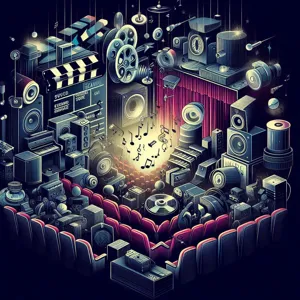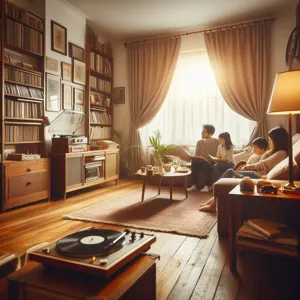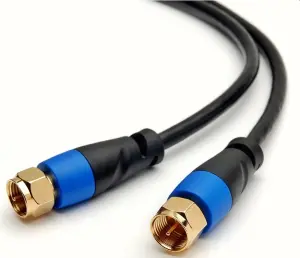In the world of PC gaming, where every sound can mean the difference between victory and defeat, having the right gaming headset is essential for an immersive experience.
The clashing of swords, the whisper of footsteps, and the explosive sounds of virtual battlefields come to life through high-quality audio, making it crucial to invest in a headset that delivers superior sound clarity and comfort. Whether you’re a casual gamer looking to enhance your enjoyment or a competitive player aiming for that edge, the right headset can elevate your gameplay to new heights. In this blog post, we’ll delve into the top 10 gaming headsets that promise not only exceptional audio quality but also features like noise cancellation, ergonomic design, and customizable settings. Get ready to discover the perfect companion for your next gaming adventure, allowing you to fully immerse yourself in the captivating worlds that await!
1. Introduction: The Importance of Quality Gaming Headsets

In the ever-evolving world of gaming, where graphics and gameplay mechanics continuously push boundaries, one aspect that often gets overshadowed is audio quality. Yet, the sound experience can significantly elevate your gaming sessions, transforming them from merely enjoyable to truly immersive. A quality gaming headset serves as the gateway to a rich auditory landscape, allowing you to hear every footstep, whisper, and explosion with stunning clarity.
Imagine diving into a fantasy world, where the rustle of leaves and distant roars create an atmosphere of tension and excitement, or engaging in a high-stakes battle where pinpoint audio cues could mean the difference between victory and defeat. A well-crafted headset not only enhances your gaming experience but also provides a competitive edge, allowing you to react swiftly to in-game sounds that others may miss.
Moreover, comfort and build quality are essential, as long gaming sessions can lead to discomfort or fatigue. The right headset should feel as good as it sounds, featuring plush ear cups, adjustable headbands, and lightweight designs that cater to hours of play without strain.
In this blog post, we will explore the top 10 gaming headsets that stand out in terms of sound quality, comfort, and functionality, ensuring you find the perfect companion for your PC gaming adventures. Whether you’re an avid gamer seeking the latest tech or a casual player looking for an upgrade, there’s a headset on this list that will elevate your gaming experience to new heights.
2. Key Features to Look for in a Gaming Headset
When it comes to selecting the ideal gaming headset for an immersive PC experience, understanding the key features that can elevate your gameplay is essential. Here are some critical aspects to consider:
**1. Sound Quality:** The heart of any gaming headset lies in its audio performance. Look for headsets that offer high-fidelity sound, with clear highs, balanced mids, and deep bass. Surround sound capabilities, particularly 7.1 virtual surround sound, can significantly enhance your gaming experience by providing directional audio cues that allow you to pinpoint the location of enemies or important in-game sounds.
**2. Comfort and Fit:** Long gaming sessions can take a toll on your ears and head, so comfort is paramount. Choose headsets with adjustable headbands, plush ear cushions, and a lightweight design. Over-ear styles typically provide better comfort, as they envelop the ears and reduce pressure. Consider models with breathable materials to keep your ears cool during prolonged use.
**3. Microphone Quality:** Communication is key in multiplayer gaming, making a quality microphone a must. Look for headsets with noise-canceling microphones that filter out background noise, ensuring your teammates hear you clearly. Detachable or adjustable mics can also be beneficial for versatility.
**4. Build Quality:** A sturdy design can withstand the rigors of intense gaming. Opt for headsets made from durable materials, such as metal or reinforced plastic, which can endure the occasional drops and pulls. Additionally, check for braided cables or wireless options to avoid tangling and wear.
**5. Battery Life (for Wireless Headsets):** If you prefer the freedom of movement that wireless headsets provide, battery life becomes a crucial factor. Look for headsets that offer extended playtime on a single charge, ideally 15 hours or more. Some models even feature quick-charge capabilities, allowing you to get back to gaming in no time.
**6. Customization Options:** Many modern gaming headsets come with customizable features, such as programmable buttons, RGB lighting, and equalizer settings. These features not only enhance your gaming experience but also allow for personalization, letting you set up your headset to match your gaming style.
**7. Compatibility:** Ensure that the headset you choose is compatible with your gaming setup. Most gaming headsets will work with PCs, but if you plan on using them with consoles or mobile devices as well, check for compatibility options, such as detachable cables or Bluetooth connectivity.
By prioritizing these key features in your search for the perfect gaming headset, you can create an audio environment that not only enhances your gameplay but also keeps you comfortable and connected with your team. Whether you’re diving into an epic battle or exploring expansive worlds, the right headset can truly transform your gaming experience.
3. Criteria for Selection: How We Chose the Top 10

When it comes to selecting the best gaming headsets for an immersive PC experience, we took a comprehensive approach to ensure that our top 10 list represents the pinnacle of audio technology and user satisfaction. Our criteria for selection were meticulously crafted, focusing on several key aspects that any serious gamer would consider essential.
**Audio Quality:** first and foremost, we prioritized audio fidelity. A headset that delivers crystal-clear sound, deep bass, and balanced mids and highs is crucial for an immersive gaming experience. We evaluated headsets based on their soundstage and clarity, ensuring that every footstep, explosion, and whisper is heard with stunning precision.
**Comfort and Build Quality:** Long gaming sessions can take a toll on comfort, so we assessed the ergonomics of each headset. Factors such as ear cup material, headband padding, and overall weight were considered to ensure a comfortable fit that allows for hours of play without fatigue. Additionally, we examined the build quality to ensure durability, as gaming gear often endures a fair amount of wear and tear.
**Microphone Performance:** Communication is key in multiplayer gaming, which is why the quality of the microphone was a significant factor. We looked for headsets equipped with noise-canceling features, adjustable boom mics, and overall voice clarity to ensure that gamers can strategize effectively without background noise disrupting their conversations.
**Compatibility and Features:** A versatile headset should be compatible with various platforms, including PC, consoles, and mobile devices. We also considered the inclusion of features like surround sound, customizable RGB lighting, and software support for sound adjustments, which can enhance the gaming experience.
**User Reviews and Expert Opinions:** Finally, we delved into user reviews and expert analyses from reputable sources in the gaming community. Real-world feedback from gamers provided invaluable insights into the performance and reliability of each headset, helping us to refine our selections further.
By combining these criteria, we crafted a list that not only highlights the best gaming headsets available but also serves as a guide for gamers looking to elevate their audio experience. Whether you’re battling in epic multiplayer showdowns or immersing yourself in rich single-player narratives, these top 10 headsets are designed to enhance your gaming adventures like never before.
4. Headset #1: Overview, Features, and Performance
When it comes to gaming headsets that deliver an unparalleled immersive experience, **The HyperX Cloud II** stands out as a top contender. This headset has gained a strong following among gamers for its exceptional sound quality and comfort, making it ideal for long gaming sessions.
**Overview**
The HyperX Cloud II combines style, durability, and advanced audio technology, all wrapped in an ergonomic design. With its sleek red and black aesthetic, it not only looks the part but also feels premium. The headset features a sturdy aluminum frame, ensuring it can withstand the rigors of intense gaming while remaining lightweight for comfort.
**Features**
One of the standout features of the HyperX Cloud II is its 53mm drivers, which deliver crystal-clear audio and deep bass, allowing players to hear every detail of their in-game environment. The headset also boasts a virtual 7.1 surround sound capability, giving gamers a spatial audio experience that enhances immersion. Whether you’re sneaking up on an opponent or navigating through a bustling game world, the sound precision makes every moment more thrilling.
Additionally, the Cloud II includes a detachable noise-cancellation microphone, which ensures that your teammates can hear you loud and clear without background noise interference. Its memory foam ear cushions provide superior comfort, enabling long hours of play without discomfort.
**Performance**
In terms of performance, the HyperX Cloud II excels across a variety of gaming genres. From first-person shooters to expansive RPGs, users report an enhanced ability to pinpoint sound direction, giving them a competitive edge. The headset is compatible with various platforms—PC, PlayStation, Xbox, and even mobile devices—thanks to its versatile 3.5mm audio jack.
Overall, the HyperX Cloud II delivers an impressive audio experience, blending comfort, durability, and sound quality into one package. It’s a perfect choice for gamers looking to elevate their gameplay with a headset that not only sounds great but also feels great during marathon gaming sessions. If you’re ready to immerse yourself in your favorite titles like never before, the HyperX Cloud II is undoubtedly a headset worth considering.
5. Headset #2: Overview, Features, and Performance

If you’re seeking an exceptional auditory experience that truly immerses you into the gaming world, look no further than the **HyperX Cloud II Gaming Headset**. Renowned for its combination of comfort, sound quality, and durability, this headset has carved a niche for itself among both casual players and competitive gamers alike.
**Overview**
The HyperX Cloud II boasts a sleek, ergonomic design that prioritizes comfort during those extended gaming sessions. With plush memory foam ear cushions and a lightweight aluminum frame, it’s built to withstand the rigors of intense gameplay without sacrificing comfort. Available in a variety of colors, this headset offers aesthetic appeal alongside its functional design, making it a staple for any gaming setup.
**Features**
One of the standout features of the Cloud II is its virtual 7.1 surround sound capability, which dramatically enhances the auditory experience. This technology allows gamers to pinpoint enemy movements and environmental sounds with incredible precision, immersing players deeper into the game. Additionally, it comes equipped with a detachable noise-canceling microphone, ensuring crystal-clear communication with teammates during multiplayer sessions. The microphone’s flexibility and retractability mean you can easily switch between gaming and music without hassle.
Moreover, the headset features a durable braided cable that prevents tangling, ensuring a clean look and feel while gaming. With in-line audio control, users can easily adjust the volume or mute the microphone without needing to navigate through complicated software menus, adding to the convenience factor.
**Performance**
When it comes to performance, the HyperX Cloud II shines brightly. Gamers rave about its balanced sound profile, which delivers rich bass without overwhelming mids and highs. Whether you’re listening to the subtle sounds of footsteps in a stealth game or the explosive audio of a first-person shooter, this headset delivers an impressive range that enhances gameplay. The noise isolation provided by the snug-fitting ear cups allows you to focus on the game without distractions, making every moment count.
In summary, the HyperX Cloud II Gaming Headset encapsulates everything a gamer could want: comfort, quality, and performance. It’s no wonder it continues to be a favorite among gamers seeking an immersive experience. If you’re ready to elevate your gaming sessions, this headset should undoubtedly be on your radar.
6. Headset #3: Overview, Features, and Performance
Introducing the **HyperX Cloud II**, a headset that has earned its reputation as one of the best in the gaming community, and for good reason. With an ergonomic design and a robust build quality, this headset promises not only comfort for those extended gaming marathons but also durability to withstand the rigors of intense use.
**Overview:**
The HyperX Cloud II is designed with gamers in mind, featuring a sleek and understated design that doesn’t compromise on performance. Equipped with both USB and 3.5mm audio options, this headset is versatile enough to work seamlessly with PCs, consoles, and even mobile devices. Its plush memory foam ear cushions and adjustable steel sliders ensure a snug fit, keeping you focused on the game without discomfort.
**Features:**
One of the standout features of the HyperX Cloud II is its **virtual 7.1 surround sound**, which creates an immersive audio experience that allows you to pinpoint the direction of in-game sounds with precision. The detachable noise-canceling microphone ensures clear communication with teammates, making it a favorite among competitive gamers. Additionally, the headset comes equipped with custom-tuned 53mm drivers that deliver rich, high-quality audio, enhancing the overall gaming experience.
**Performance:**
When it comes to performance, the HyperX Cloud II shines, providing an excellent balance of bass, mids, and highs. Whether you’re engaged in a high-octane shooter or exploring vast open-world landscapes, the audio clarity and depth are exceptional. The virtual surround sound elevates gameplay, allowing you to hear the faintest footsteps of opponents or the distant roar of a dragon, immersing you fully in your gaming world.
In summary, the HyperX Cloud II combines comfort, versatility, and high-quality audio performance, making it a top choice for gamers looking to enhance their PC gaming experience. Whether you’re a casual player or a hardcore competitor, this headset ensures you won’t miss a beat, keeping you in the thick of the action.
7. Headset #4: Overview, Features, and Performance

When it comes to elevating your gaming experience, the **SteelSeries Arctis Pro** stands out as a remarkable contender in the competitive world of gaming headsets. Designed for serious gamers who demand both exceptional sound quality and comfort, the Arctis Pro seamlessly combines premium materials with cutting-edge technology.
**Overview**
The SteelSeries Arctis Pro features a sleek, modern design that is both aesthetically pleasing and functional. The adjustable headband is constructed from lightweight aluminum and steel, ensuring durability while providing a comfortable fit. With its soft, breathable ear cushions made from a specially designed fabric, this headset is perfect for those extended gaming sessions without causing any discomfort.
**Features**
One of the standout features of the Arctis Pro is its high-fidelity audio. Equipped with premium speaker drivers, this headset delivers crystal-clear sound with a wide dynamic range, allowing gamers to hear every subtle detail—from the rustle of leaves to the distant footsteps of an approaching enemy. The headset also supports Hi-Res Audio, which means it can reproduce sound at higher frequencies, making your gaming experience even more immersive.
The Arctis Pro also boasts a dual-wireless system, allowing you to connect via both Bluetooth and a USB dongle. This means you can easily switch between gaming on your PC and taking calls or listening to music on your mobile device without missing a beat. Additionally, the headset features customizable RGB lighting, allowing you to personalize your setup and create a visually stunning gaming environment.
**Performance**
In terms of performance, the SteelSeries Arctis Pro excels in delivering a rich, immersive audio experience. Gamers will appreciate the headset’s ability to provide directional sound, which is crucial for competitive gaming where situational awareness is key. The clear and responsive microphone ensures that your voice comes through loud and clear, making communication with teammates effortless.
Overall, the SteelSeries Arctis Pro is a top-tier gaming headset that balances style, comfort, and performance. Whether you’re diving into an intense multiplayer match or exploring vast open worlds, this headset enhances your gaming experience, keeping you engaged and connected to the action like never before.
8. Headset #5: Overview, Features, and Performance
The **Razer BlackShark V2** is a true powerhouse in the realm of gaming headsets, elevating your auditory experience to a new level. Designed with both competitive and casual gamers in mind, this headset strikes a perfect balance between comfort, sound quality, and functionality.
**Overview:**
The BlackShark V2 boasts a sleek, professional design that is as stylish as it is functional. Its lightweight frame is complemented by plush memory foam ear cushions that ensure hours of comfortable gameplay without fatigue. This headset is particularly known for its exceptional sound isolation, allowing you to immerse yourself fully in your game without being distracted by external noise.
**Features:**
One of the standout features of the BlackShark V2 is its advanced **TriForce Titanium 50mm drivers**, which deliver a rich and dynamic audio profile. These drivers are engineered to produce high, mid, and low frequencies separately, resulting in crystal-clear highs, detailed mids, and deep, resonant bass. This setup is perfect for picking up subtle in-game sounds, giving you a tactical advantage in competitive scenarios.
Additionally, the headset comes equipped with **THX Spatial Audio**, which provides a realistic 3D soundscape. This feature enhances your gaming experience, allowing you to accurately locate enemies and feel the environment around you. Whether you’re navigating the battlefields of your favorite FPS or exploring vast open worlds, the spatial audio captures every nuance.
Furthermore, the BlackShark V2 features a detachable **HyperClear cardioid microphone**, ensuring your voice is heard loud and clear during multiplayer sessions. This microphone minimizes background noise and is versatile enough for both gaming and streaming, making it a favorite among content creators.
**Performance:**
In terms of performance, the Razer BlackShark V2 excels across the board. Users rave about its impressive sound quality, noting how it enhances gameplay by providing an immersive experience that draws them into the virtual world. The adjustable ear cups and headband allow for a snug fit, reducing sound leakage and enhancing the overall audio experience.
The headset’s compatibility with multiple platforms—PC, console, and even mobile devices—adds to its versatility, making it a worthy investment for any gamer. The intuitive controls on the ear cups allow for quick adjustments to volume and microphone mute, ensuring you have full control over your audio experience without interruptions.
In summary, the Razer BlackShark V2 is more than just a gaming headset; it’s an essential tool for anyone looking to enhance their gaming experience. With its outstanding features and stellar performance, it’s no wonder it ranks among the top choices for gamers seeking immersion and clarity in their gameplay.
9. Headset #6: Overview, Features, and Performance
The SteelSeries Arctis Pro is a standout choice that combines premium sound quality with a sleek, comfortable design, making it a top contender for immersive gaming sessions. This headset is engineered for those who refuse to compromise on audio performance, featuring high-fidelity speakers that deliver a remarkable frequency range of 10 to 40,000 Hz. This wide bandwidth ensures that every game sound, from the faint rustle of leaves in a stealth mission to the thunderous explosions of an action-packed battleground, is rendered with stunning clarity and depth.
One of the most notable features of the Arctis Pro is its dual-wireless technology, allowing for both Bluetooth and a lossless 2.4 GHz wireless connection. This versatility means you can seamlessly switch between gaming on your PC and taking calls or listening to music on your mobile device without missing a beat. The headset also comes equipped with RGB lighting on the ear cups, which can be customized to match your gaming setup or personal style, adding an extra flair to your overall aesthetic.
Comfort is paramount in the design of the Arctis Pro, with soft, breathable fabric ear cushions and a lightweight aluminum frame that ensures hours of wear without discomfort. The adjustable ski goggle headband distributes weight evenly, preventing pressure points that can lead to fatigue during extended gaming sessions.
In terms of performance, the Arctis Pro excels with its ClearCast microphone, which utilizes a bidirectional design to provide crystal-clear voice clarity while minimizing background noise. This makes it an excellent choice for competitive gamers who need to communicate effectively with their teammates without distractions.
Overall, the SteelSeries Arctis Pro offers an unparalleled gaming experience with its combination of top-notch audio performance, ergonomic design, and versatile connectivity options. Whether you’re diving into an immersive single-player campaign or battling it out in multiplayer matches, this headset is sure to elevate your gaming experience to new heights.
10. Headset #7: Overview, Features, and Performance
When it comes to delivering an exceptional audio experience, Headset #7 stands out as a top contender in the gaming headset market. Designed with gamers in mind, it combines cutting-edge technology and thoughtful features to enhance your overall gaming experience.
**Overview**
Headset #7 showcases a sleek and modern design, available in a variety of color options that cater to different gaming aesthetics. With adjustable ear cups and a lightweight frame, this headset provides comfort for long gaming sessions, ensuring that your focus remains on the game and not on discomfort.
**Features**
One of the standout features of Headset #7 is its advanced 7.1 surround sound capability, which immerses players in a rich audio landscape. This feature allows gamers to pinpoint the direction of sounds, whether it’s the subtle rustle of footsteps behind you or the distant roar of an approaching vehicle. The headset also includes customizable RGB lighting that syncs with your gameplay, providing a visually stimulating experience.
The noise-canceling microphone is another highlight, offering crystal-clear communication with teammates. With a flip-to-mute feature, players can easily silence themselves when needed, ensuring that no background noise disrupts their gaming sessions. Additionally, Headset #7 is compatible with multiple platforms, including PC, PlayStation, and Xbox, making it a versatile choice for gamers who dabble in various ecosystems.
**Performance**
In terms of audio performance, Headset #7 delivers dynamic sound quality with deep bass and clear treble, enhancing everything from explosive action sequences to soft, ambient sounds. The headset’s audio drivers are engineered for precision, allowing for an immersive gaming experience that brings every detail to life.
User reviews highlight the headset’s durability and reliability, with many praising its long-lasting battery life and the comfort of the ear cushions even during extended wear. Whether you’re engaged in an epic battle or exploring vast open worlds, Headset #7 ensures that you’re not just a player but a participant in the gaming universe.
In summary, Headset #7 is a formidable option for gamers looking for high-quality audio, comfort, and functionality. With its impressive features and outstanding performance, it’s no wonder this headset has earned its place among the top contenders for an immersive PC gaming experience.
11. Headset #8: Overview, Features, and Performance
As we delve into our eighth selection, the **Razer Nari Ultimate**, prepare to be enveloped in a world of sound that transforms your gaming experience. This headset is not just about aesthetics; it combines cutting-edge technology with comfort, making it a formidable contender in the gaming headset arena.
**Overview:**
The Razer Nari Ultimate is designed for gamers who seek both performance and comfort. Featuring Razer’s HyperSense technology, this wireless headset offers haptic feedback that allows you to feel in-game actions like explosions and footsteps, adding a visceral element to your gameplay. Its sleek design, with customizable RGB lighting, ensures that it looks as good as it sounds, appealing to both casual and hardcore gamers alike.
**Features:**
– **Wireless Connectivity:** Enjoy the freedom of movement with Razer’s advanced wireless technology, boasting a range of up to 40 feet and a reliable connection for uninterrupted gaming sessions.
– **THX Spatial Audio:** Immerse yourself in a 360-degree soundscape with THX Spatial Audio, which enhances the directional sound cues, providing a competitive edge in multiplayer games.
– **Comfort-Centric Design:** With plush cooling gel-infused ear cushions and an adjustable headband, the Nari Ultimate ensures comfortable wear for long hours, reducing fatigue during extended gaming marathons.
– **Dual-Functionality:** The headset features a retractable microphone with noise cancellation, ensuring clear communication with your teammates while minimizing background distractions.
**Performance:**
In terms of performance, the Razer Nari Ultimate stands out for its rich sound quality and immersive experience. The bass is deep and powerful, perfect for action-packed games, while the mids and highs are crisp and clear, allowing for detailed audio cues. The haptic feedback feature is a game-changer, as it enhances the overall experience, making each gunfire and explosion feel tangible. Gamers have praised the headset’s ability to seamlessly switch between gaming and music, offering versatility for those who enjoy streaming or listening to playlists between sessions.
In summary, the Razer Nari Ultimate is a true powerhouse that combines innovative features with top-notch performance, making it a must-have for any serious gamer looking to elevate their PC gaming experience. Whether you’re navigating vast virtual worlds or engaging in competitive matches, this headset will ensure you remain fully immersed in every moment.
12. Headset #9: Overview, Features, and Performance
The **HyperX Cloud II** is a standout choice for gamers seeking an immersive audio experience without breaking the bank. Renowned for its comfort and exceptional sound quality, this headset has garnered a loyal following among both casual and hardcore gamers alike.
#### Overview
The HyperX Cloud II boasts a sleek and understated design, featuring a durable aluminum frame that can withstand the rigors of daily gaming sessions. Its plush memory foam ear cushions provide a snug fit, ensuring hours of comfortable gameplay without fatigue. The headset is compatible with multiple platforms, including PC, Xbox, PlayStation, and even mobile devices, making it a versatile addition to any gamer’s arsenal.
#### Features
One of the most notable features of the HyperX Cloud II is its virtual 7.1 surround sound capability. This audio technology creates an immersive soundstage, allowing players to pinpoint the direction of in-game sounds with remarkable accuracy. Whether it’s the subtle rustle of an enemy sneaking up behind you or the distant rumble of an explosion, the headset elevates your gaming experience to new heights.
Additionally, the Cloud II includes a detachable noise-canceling microphone that ensures crystal-clear communication with teammates. The microphone’s flexibility allows for easy adjustments, and its ability to filter out background noise makes it an excellent choice for competitive gaming scenarios.
#### Performance
In terms of performance, the HyperX Cloud II excels in delivering rich, balanced audio. The headset’s 53mm drivers produce clear highs, deep lows, and a well-defined midrange, making it suitable for various genres, from intense first-person shooters to immersive role-playing games. Players have noted a significant improvement in their situational awareness, which has translated into better in-game performance and higher kill ratios.
Furthermore, the headset features an in-line audio control, allowing users to adjust the volume and mute the microphone effortlessly. This thoughtful design ensures that players can maintain focus on their game without fumbling with settings.
Overall, the HyperX Cloud II offers an impressive combination of comfort, versatility, and audio performance, making it an ideal choice for gamers looking to enhance their PC gaming experience without spending a fortune. Whether you’re diving into the latest AAA title or enjoying a classic indie gem, this headset is sure to keep you engaged in the action.
13. Headset #10: Overview, Features, and Performance
As we reach the final entry in our list of top gaming headsets, Headset #10 stands out as a versatile option that balances performance, comfort, and affordability. Designed for avid gamers who seek an immersive audio experience without breaking the bank, this headset combines cutting-edge technology with user-friendly features.
**Overview**
Headset #10 boasts a sleek, modern design that is both lightweight and durable, ensuring it can withstand countless gaming sessions. The adjustable headband and plush ear cushions provide a snug fit, allowing players to lose themselves in their favorite games for hours on end. With a wired connection, users benefit from zero latency and consistent audio quality, making it an ideal choice for competitive gaming.
**Features**
Equipped with high-fidelity 50mm drivers, this headset delivers rich, immersive sound, allowing you to hear every footstep, explosion, and subtle sound effect in stunning detail. The omnidirectional microphone captures crystal-clear voice communication, ensuring your teammates hear you loud and clear during intense multiplayer matches. Additionally, the headset features customizable RGB lighting that adds a touch of flair to your gaming setup, making it not only a functional accessory but also a stylish one.
**Performance**
When it comes to performance, Headset #10 excels in delivering an exceptional audio experience. The bass response is deep and punchy, ideal for action-packed games, while the mids and highs are crisp and clear, bringing dialogue and environmental sounds to life. The headset also includes a built-in volume control and mute function on the ear cup, allowing for quick adjustments without interrupting your gameplay.
For gamers looking for a headset that offers a blend of quality, comfort, and value, Headset #10 is a worthy contender. With its impressive sound performance and gamer-friendly features, it ensures that you not only hear every detail but also feel as if you are right in the middle of the action. Whether you’re embarking on epic quests in sprawling RPGs or competing in fast-paced shooters, this headset will enhance your gaming experience in ways you never imagined.
14. Comparing the Top Picks: Which One is Right for You?
When it comes to choosing the perfect gaming headset, the sheer variety of options can be overwhelming. Each headset on our list boasts unique features tailored to different gaming experiences, and understanding these nuances is crucial for making an informed decision.
Let’s break down our top picks to help you find the ideal match for your gaming needs.
**1. HyperX Cloud II**: Renowned for its exceptional comfort and sound quality, the HyperX Cloud II features memory foam ear cushions and a durable aluminum frame. This headset is perfect for long gaming sessions, offering a balanced audio profile that elevates everything from immersive soundscapes to crisp voice chat. If you value comfort as much as performance, this could be your go-to option.
**2. SteelSeries Arctis Pro**: With its high-fidelity audio and sleek design, the SteelSeries Arctis Pro stands out for its versatility. Equipped with a dual-wireless system, it allows for both Bluetooth and 2.4GHz connections, making it ideal for gamers who switch between devices. If you’re looking for a premium headset that delivers stunning audio clarity and flexibility, consider this one.
**3. Razer BlackShark V2**: Featuring Razer’s innovative TriForce drivers, the BlackShark V2 offers detailed sound that enhances every gaming session. The detachable microphone is a bonus for streamers, ensuring clear communication with teammates. For gamers who prioritize sound customization, the Razer Synapse software allows for deep audio tweaks.
**4. Logitech G Pro X**: This headset is designed with esports in mind, combining comfort and competitive audio performance. The Blue VO!CE mic technology provides studio-quality sound, making it a favorite among professional gamers. If you seek precision and clarity in communication, the Logitech G Pro X may be the headset for you.
**5. Corsair Void Elite**: With its unique design and RGB lighting, the Corsair Void Elite not only delivers excellent sound but also adds a bit of flair to your gaming setup. Its 7.1 surround sound feature enhances immersion, making it an exciting choice for those who love action-packed games.
When comparing these top picks, consider factors such as comfort, sound quality, battery life, and additional features that may enhance your gaming experience. Whether you’re a casual gamer looking for a budget-friendly option or a hardcore enthusiast ready to invest in premium audio, there’s a headset tailored just for you. Take your time to assess what matters most in your gaming routine, and you’ll be well on your way to finding the perfect companion for your immersive PC experience.
15. Conclusion: Enhancing Your Gaming Experience with the Right Headset
In the ever-evolving world of gaming, the right headset can make all the difference between a good experience and an unforgettable one. As we’ve explored in this list of the top 10 gaming headsets, sound quality, comfort, and advanced features play pivotal roles in creating an immersive environment that transports you straight into the heart of your favorite virtual worlds.
The perfect gaming headset not only delivers crystal-clear audio but also enhances your ability to communicate with teammates, allowing for strategic coordination and camaraderie. Whether you’re navigating treacherous terrains in an open-world adventure, competing in fast-paced multiplayer battles, or simply enjoying the atmospheric soundscapes of your favorite indie title, the right headset elevates your gameplay.
Additionally, comfort is paramount. Long gaming sessions can lead to fatigue when wearing a headset that doesn’t fit well or lacks adequate padding. The models we’ve highlighted are designed with ergonomics in mind, ensuring that you can dive into your gaming marathons without discomfort.
Moreover, as technology continues to advance, features such as surround sound, customizable audio profiles, and built-in microphones are becoming standard. These innovations not only enhance your auditory experience but also allow for greater immersion and interaction within your gaming community.
In conclusion, investing in a quality gaming headset is essential for any serious gamer looking to enhance their overall experience. As you gear up for your next adventure, consider the headsets we’ve discussed. With the right choice in your arsenal, you’ll be ready to conquer new challenges, forge lasting friendships, and enjoy every moment of your gaming journey. Happy gaming!
In conclusion, choosing the right gaming headset can truly elevate your PC gaming experience, immersing you in a world of stunning audio and exceptional comfort. Our list of the top 10 gaming headsets showcases a variety of options to suit different preferences and budgets, ensuring that every gamer can find the perfect match for their needs. From crystal-clear sound quality to advanced features like surround sound and customizable settings, each headset offers unique benefits that can enhance your gameplay. As you embark on your next gaming adventure, remember that the right headset can be the key to achieving that immersive experience you crave. Happy gaming, and may your new headset bring you countless hours of thrilling enjoyment!















